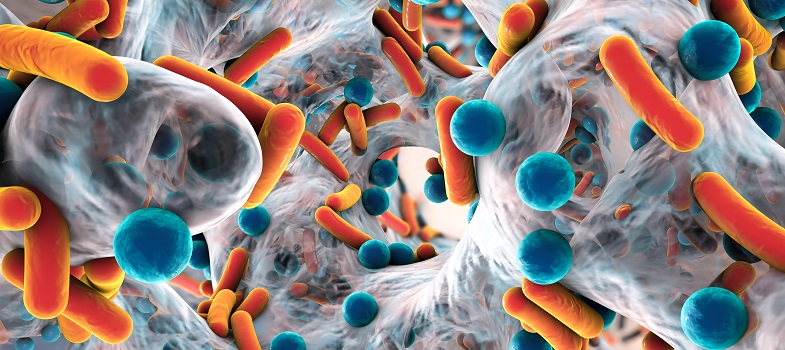Glossary
Special | A | B | C | D | E | F | G | H | I | J | K | L | M | N | O | P | Q | R | S | T | U | V | W | X | Y | Z | ALL
A |
|---|
acquired resistanceResistance to an antibiotic to which a bacterium is innately susceptible. It occurs when a bacterium acquires the ability to resist the actions of a particular antibiotic through either genetic mutation or horizontal gene transfer. | |
amino acidThe individual unit from which proteins are constructed. | |
antimetabolitesChemicals that are structurally similar to natural metabolites but just different enough to interfere with normal cell function. | |
B |
|---|
bactericidalAntibiotic that kills bacteria. | |
bacteriophageA virus that infects bacteria. | |
bacteriostaticAntibiotics that stop or slow bacterial growth. | |
broad-spectrumAntibiotics that affect (either kill, or stop reproducing) a wide range of bacteria: particularly, both Gram-positive and Gram-negative species. | |
C |
|---|
chromosomesDNA molecules containing some, or all, of the genetic information of an organism. | |
E |
|---|
efflux pumpTransport proteins in the bacterial membrane that actively transport antibiotics out of the bacterial cell. | |
enzymesProteins that speed up (catalyse) chemical reactions in living organisms. | |
eukaryotesOne of the two main categories of living things (the other is prokaryotes). Eukaryotic organisms, including humans and animals, have cells containing nuclei and other membranous organelles. | |
G |
|---|
geneA sequence of DNA that encodes the amino acid sequence of a particular protein. | |
genetic mutationsChanges in the sequence of DNA due to either errors made while copying the DNA or environmental factors. Genetic mutations in genes can result in changes to the amino acid sequence encoded by the gene and may change the function of the resulting protein. | |
Gram-negativeBacteria that do not retain crystal violet dye in the Gram-staining test. | |
Gram-positiveBacteria with a thick peptidoglycan layer in their cell wall that is stained blue–purple by the Gram stain dye. | |
H |
|---|
I |
|---|
intrinsic resistanceThe innate ability of a bacterial species to resist the action of antibiotic as a consequence of the bacteria’s structural or functional characteristics. | |
isolatesA bacterial strain separated from a mixed population of microbes such as those found in the soil or inside the gut. | |
M |
|---|
metabolismThe chemical reactions in an organism that allow it to obtain the energy and nutrients it needs to grow and survive. | |
metabolitesThe intermediates and products of metabolism. | |
N |
|---|
narrow-spectrumAntibiotics that only affect a small range of bacterial types. | |
P |
|---|
peptidoglycanA major component of bacterial cell walls. A large polymer, consisting of sugars and amino acids, that forms a mesh-like layer outside the bacterial cell membrane. | |
plasmidA circular, non-chromosomal piece of DNA often carrying genes associated with a particular function, e.g. antibiotic resistance. | |
porinA transmembrane protein complex that allows the movement of small molecules across the bacterial outer membrane. | |
prokaryotesOne of the two main categories of living things (the other is eukaryotes). Prokaryotic cells lack a nucleus, mitochondria and other membrane-bound organelles. | |
R |
|---|
replicationThe synthesis of an exact copy of a DNA molecule. | |
S |
|---|
selective toxicityThe targeting of drugs to affect only the disease-causing, pathogenic organism and minimise damage to the host cells and commensal mico-organisms. | |
structural analogueA compound having a structure similar to that of another compound but a different function. | |
T |
|---|
transductionA horizontal gene transfer mechanism in which plasmids are transferred from one bacterium to another, mediated by a virus. | |
V |
|---|
vertical gene transferThe transfer of genetic information from a parent to its offspring. | |
virusAn infectious agent that is approximately ten times smaller than a bacterium and cannot replicate outside a host cell. Viral infections cannot be treated with antibiotics. | |
For further information, take a look at our frequently asked questions which may give you the support you need.
If you have any concerns about anything on this site please get in contact with us here.



